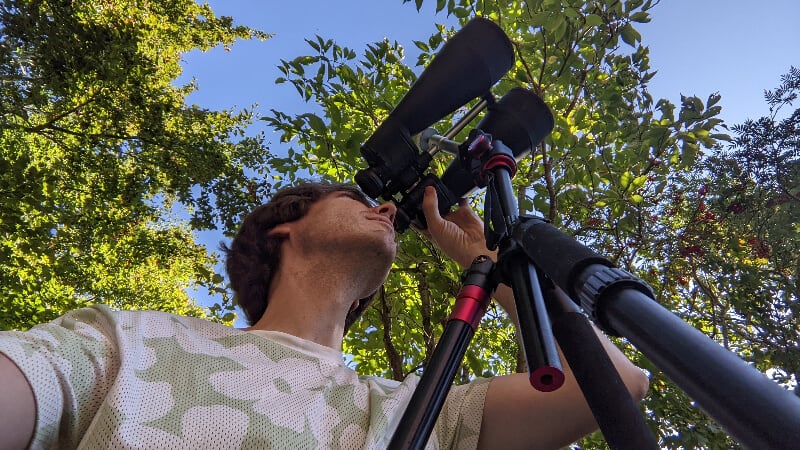The main difference between spotting scopes and binoculars is that binoculars allow you to use both your eyes, whilst with spotting scopes you use just one. However, spotting scopes do have some advantages depending on what you want to use them for.
In this article, we explore the pros and cons of spotting scopes vs binoculars to help you decide what’s right for you.
Our focus is in relation to astronomy and astrophotography, but we do also touch on other terrestrial uses like bird watching, hunting, shooting, and ocean-viewing.
Spotting Scope vs Binoculars: What’s the Difference?
When it comes down to it, binoculars are essentially two spotting scopes attached together so that you have one for each eye.
The components and design inside are essentially the same, but there are some key differences that may be important depending on what you are using them.
What is a Spotting Scope?
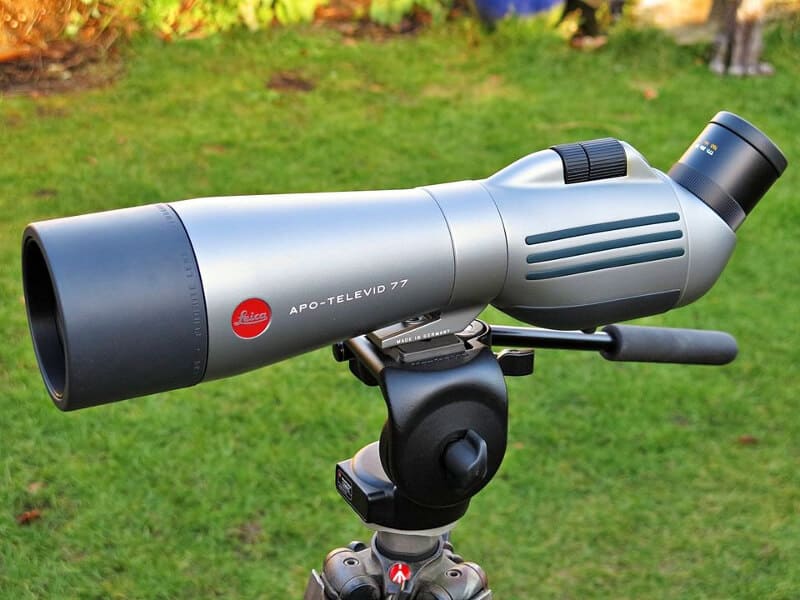
A spotting scope is essentially a small, compact telescope that uses a glass lens to allow you to see objects that are far away through an eyepiece.
Spotting scopes are generally optimized for daytime terrestrial purposes like bird watching, ocean-viewing, target shooting, or long-range shooting, but there are a number of models that are specialized for stargazing (see the Best Spotting Scopes for Astronomy).
Like telescopes, the key specification of a spotting scope is its aperture which is usually stated in the model name. For example, the Celestron Regal M2 80ED Spotting Scope has an aperture of 80mm.
Aperture is the measurement of the size (diameter) of the lens. The higher this is the better, as the views provided will be clearer and brighter. Usually though, the higher the aperture, the more expensive the spotting scope.
What are Binoculars?
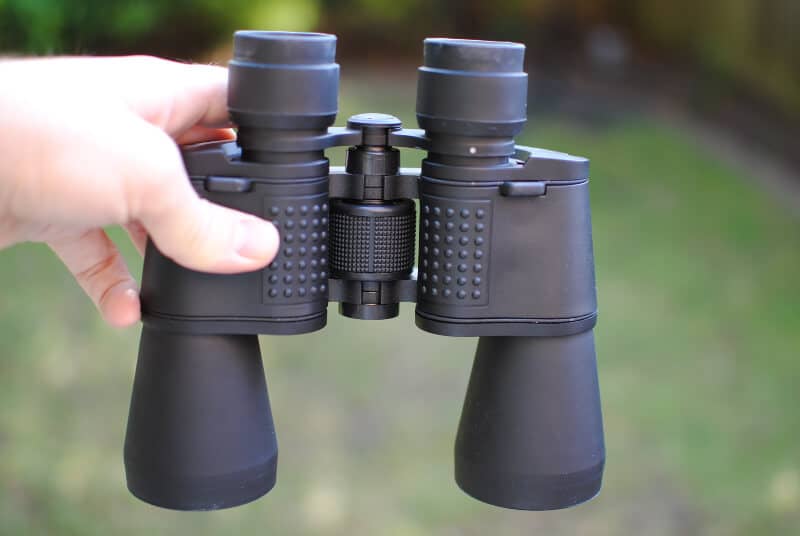
Binoculars are essentially two spotting scopes housed together to allow you to see through with both eyes.
Again, the key specification is aperture, but the magnification is usually stated in the model name too. For example, the Celestron SkyMaster 25×70 Binoculars have:
- 25x magnification
- 70mm aperture
Binoculars are usually for handheld use, but there are bigger astronomy binoculars that need to be used with a tripod to keep them steady enough to see far-off objects due to high magnification and their weight.
Spotting Scopes vs Binoculars for Astronomy: Pros and Cons
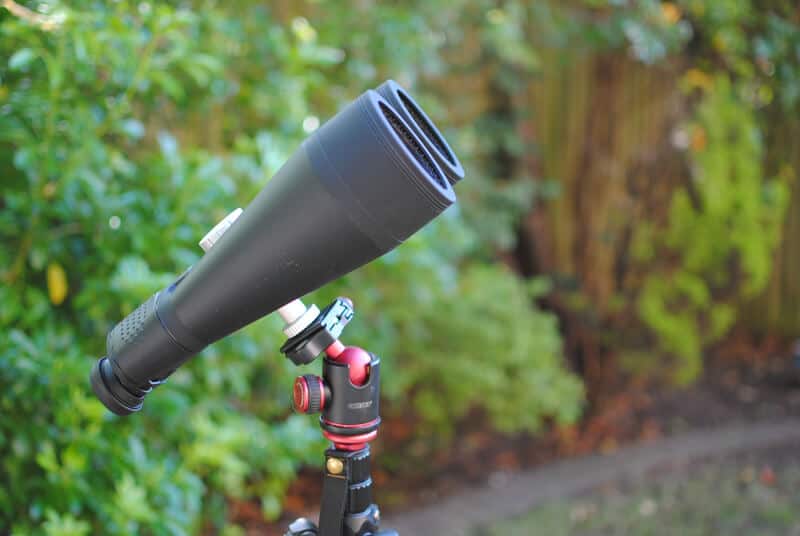
Both spotting scopes and binoculars can be used as alternatives to telescopes for astronomy.
In fact, both have some advantages over telescopes in certain circumstances – to read more on this, see Spotting Scopes vs Telescopes and the Best Binoculars for Astronomy.
But what are the pros and cons of binoculars vs spotting scopes?
The advantages of spotting scopes over binoculars are:
- They are lighter and smaller. This is simply because they only have one tube with lenses, whereas binoculars have two.
- They are usually cheaper than astronomy binoculars at the same aperture. Again, this is the result of them being half the materials.
- They are better suited to photography and astrophotography. See more on this below.
- They tend to have higher magnification and therefore a narrower field of view. This makes them better for zooming in on specific objects, like the moon, the planets, or a deep-sky object like a galaxy.
- They are often weather-proof and/or water-proof since they are primarily designed to be used in the daytime when the elements might be temperamental. In contrast, astronomy binoculars (and telescopes) are rarely weather-proof as you will never be stargazing under clouds.
The advantages of binoculars over spotting scopes are:
- They can be used by hand (unless they are larger models with higher magnification and/or aperture)
- They allow you to use both eyes when viewing, which is better for most people. (Note though that you can get spotting scopes with dual eyepieces – see here.)
- They tend to have lower magnification and therefore a wider field of view. This makes them better for observing larger expanses of the sky, and low magnification models can be perfect for watching meteor showers, etc.
The real key here is what do you want to use the binoculars or spotting scope for:
- A spotting scope (especially a good one for astronomy) can be considered as a mini astronomical telescope that is simpler, cheaper, and more versatile than a telescope, but less designed specifically for astronomy.
- A pair of binoculars can serve a quite different purpose and the appeal – especially with a low magnification model – is to have something that’s easy just to have lying around that you can just pick up and take outside with no preparation or set up.
Spotting Scopes vs Binoculars for Photography (and Astrophotography)
Is there a better option between spotting scopes and binoculars for photography?
The answer is yes, spotting scopes will generally be better than binoculars for photography AND astrophotography.
Both spotting scopes and binoculars can be used to take photos and the easiest way is with a smartphone adapter:
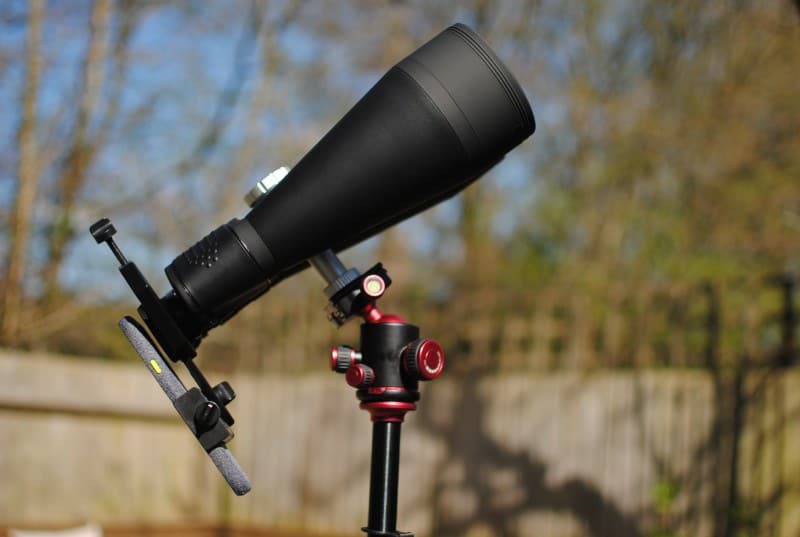
Obviously, with this you are limited to using your smartphone to take the photos, and – depending on what you are shooting – this can be no problem at all. With astrophotography, you will definitely be able to get some good shots of the moon and maybe some of the planets with your smartphone if the conditions are right and your scope/binoculars are good enough.
But using a “real” camera will nearly always be better than your smartphone camera.
Therefore there are two reasons why spotting scopes are better than binoculars for photography:
- It’s simpler and less fiddly to attach a smartphone to a spotting scope. When you attach one to binoculars the second eyepiece that you are not using becomes redundant and just gets in the way.
- Some of the bigger spotting scopes like the Celestron C5 and C90 are capable of having DLSR or mirrorless cameras attached directly to them. This can hugely elevate your potential for imaging and even deep-sky astrophotography.
Binoculars vs Spotting Scope: FAQs
What is better: binoculars or a spotting scope?
There is no real better, you have had to work out what you are planning to do and then find the right model of binocular, spotting scope, telescope, or monocular to suit you.
Check out this video from Optics Trade where they discuss the pros and cons from the point of view of specialists in terrestrial pursuits:
What is a spotting scope good for?
Spotting scopes are good for terrestrial activities like bird-watching, hunting, ocean viewing, and shooting.
Some specialized models are good for astronomy, however there are some downsides, particularly in that are designed to be looked through at the horizon and not up at the sky. Therefore they can be uncomfortable for use stargazing.
What’s the difference between a spotting scope and binoculars?
They are very similar in terms of how they operate, with the main difference being that binoculars have two separate optical devices (one for each eye). You can think of them as two spotting scopes strapped together.
Whilst you can get spotting scopes with dual eyepieces, the difference is that both eyes are looking through the same optical tube and lens.
Are spotting scopes more powerful than binoculars?
You can buy spotting scopes and binoculars in a similar range of specifications. The best measure of “power” is aperture as that is the most significant determinant of the viewing capacity it will provide.
From our research:
- The most powerful spotting scope we have found is the Celestron C5, with 127mm aperture.
- The most powerful astronomy binoculars we have found are the APM 150mm 45 ED-APO Binoculars, with 150mm aperture.
Another measure of “power” could be magnification. In general, spotting scopes will have higher magnification and therefore a more zoomed-in – but narrower – field of view.
What is best: spotting scopes vs binoculars for bird watching, hunting, shooting & ocean viewing?
It all depends on a number of things:
- Whether you want to use two eyes or one
- Whether you want something smaller and more portable (usually binoculars)
- Whether you want something with a wider field of view for scanning (binoculars) or a more zoomed-in narrower field of view (spotting scope)
Another option to consider is a monocular, which is even more compact and portable than spotting scopes.
What is best: spotting scopes vs binoculars for kids?
Both spotting scopes and binoculars can work for kids.
Just think about who will be using them and how. Larger scopes and binoculars will need to be used with tripods and the child (depending on their age and capability) may need help with this.
However, smaller and lighter devices can be used handheld but are less capable of delivering views.
What is best: spotting scopes vs telescopes for astronomy?
Telescopes are more tailored to astronomy and so are generally better. However, spotting scopes have a number of advantages including their versatility for daytime use.
Read Spotting Scopes vs Telescopes for Astronomy for more on this.
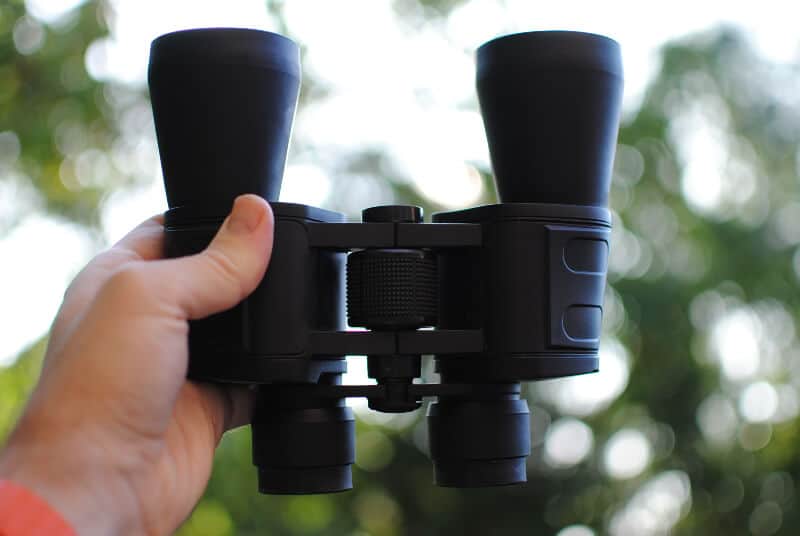
Final Word: Binoculars or Spotting Scope?
If you are looking for a device for astronomy, a telescope will generally be best, but astronomy binoculars and spotting scopes are generally much simpler, cheaper, and great for grab-and-go use, and can be perfect as a first step.
Only a few models of spotting scopes are useable for astronomy and they are less optimized for this than telescopes or astronomy binoculars, but they do have some advantages in relation to their greater versatility and durability.
Many people opt for a pair of astronomy binoculars as the first bit of stargazing gear they get and we endorse this. For relatively cheap, you can get a good pair that is easy to use and store.
For more related information, please check out:


